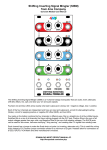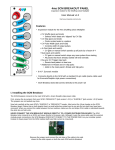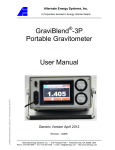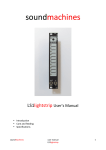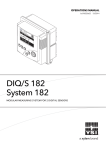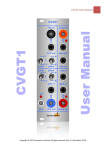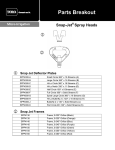Download SCM Breakout User Manual
Transcript
4ms SCM BREAKOUT PANEL expansion module for the Shuffling Clock Multiplier User Manual v2.0 http://www.4mspedals.com/scm.php Features • Expansion module for the 4ms Shuffling Clock Multiplier: • CV Shuffle (jack and knob) • Selects which beats are “slipped” by CV Slip • CV Skip (jack and knob) • Omits certain beats in a pattern • CV Pulse Width (jack and knob) • Controls width of output pulses • 4x Fast (jack and switch) • CV gate or manual switch speeds up all jacks by a factor of 4 • Button turns 4x Fast on/off, or inverts incoming signal on jack • Mute (jack and button) • CV gate or manual switch stops any more pulses from starting • All pulses that have already started will end normally • Button turns Mute on/off, or inverts incoming signal on jack • Re-sync CV Trigger input jack • Resets beat pattern to beat one • Additional CV Rotate and CV Slip jacks • Adds to the main panel's Rotate and Slip jacks • 8 H.P. Eurorack module • Connects directly to the SCM with a standard 16-pin cable (same cable used for Eurorack/Doepfer style power connections) • SCM Breakout does not connect directly to the power rail New features since version 1: • • • • Mute and 4x Fast are LED buttons Pressing Mute and 4x Fast inverts signal on jack Knobs are centered straight up (12:00) Rotate and Slip knobs act as attenuators to breakout jacks, and the corresponding jacks on the main SCM module are added to this attenuated signal. I. Installing the SCM Breakout The SCM Breakout connects to the main SCM with a 16-pin Doepfer-style power cable. First, remove the six jumpers from your SCM on the "BREAKOUT" or "JUMP/B-O" header. Now connect the cable from the SCM Breakout to the SCM's header. When you connect the cable between the two modules, make sure the red stripe of the cable is orientated towards bottom of both modules. NEVER CONNECT THE SCM BREAKOUT MODULE DIRECTLY TO A POWER DISTRUBUTION BOARD! The SCM Breakout only connects to an SCM, and never directly to the power rails. Although it uses the same cable used for eurorack module power connections, the SCM Breakout DOES NOT CONNECT TO THE POWER RAILS on your modular system. Instead, it draws power from the SCM module itself (very little current is consumed). II. Operation Getting Started A good way to start is to first turn the knobs to their default settings: Shuffle, Skip, and Rotate all the way down (counter/anticlockwise); Slip and PW turned to center. Also, press both buttons off so that 4x Fast and Mute are not engaged. This is the default setting for an SCM with no breakout and nothing plugged into Slip or Rotate. A fun sample patch to try is to run a slow clock into the SCM's clock input, and use the S8 and x8 jacks to open two different VCAs, Low Pass Filters or Low Pass Gates. Run an oscillator or some sound source into both VCAs/LPGs and mix the outputs together so you can hear both at the same time. Now on the SCM Breakout, turn Rotate, Shuffle, and Skip all the way down. Turn PW to 50% and adjust to suit your ears. Now play with Slip, slowly turn the knob along its full range and listen to how every other beat from the S8 jack lands later and later as you turn Slip up. Now nudge Shuffle up until the beat pattern changes. Play with Slip some more... keep nudging Shuffle up and playing with Slip. Once you get a feel for all the possibilities with those two knobs, start playing with the Skip knob: you should hear some beats drop out of the S8 sound but the x8 will continue thumping steadily along. Using CV and the Knobs at the Same Time To modulate a parameter, you can simply turn the knob until you get the desired result. Also, you can feed a CV signal into the associated jack. The jacks and knobs interact as follows: Skip, PW, Shuffle: The knob sets the offset, and the jack signal is added to the knob's setting (or subtracted when there's a negative voltage on the jack) Rotate, Slip jacks on SCM Breakout: The knob attenuates the jack's signal. Turning the knob down all the way will make the jack do nothing. Rotate, Slip jacks on main SCM: Running a signal into these jacks will add to the attenuated signal set by the knob and breakout's jack. In this way, you can plug into the main SCM's Rotate or Slip jack and use the knob as an offset (with nothing plugged into the breakout's jack)... or you can plug into the breakout and not the main module and use the knob as an attenuator. Using the buttons and jacks The 4x Fast button and the Mute buttons act as inverters if something is plugged into the jack. This is very useful for creating complex patterns by connecting RCDs and SCMs together. III. Description of Controls CV Shuffle CV Shuffle is closely related to CV Slip, which is described in the main SCM manual (download from http://www.4mspedals.com/scm.php). While Slip controls the amount that certain beats are pushed forward in time, Shuffle controls which beats are slipped. The default setting is every other beat (Shuffle at minimum). As you turn Shuffle up, first every third beat will be slipped, then every fourth beat, fifth, sixth, and finally at a certain point in the knob's range, every seventh beat will be pushed forward. From the this point in the range to the maximum, Shuffle behaves differently. Instead of pushing just one beat forward, it pushes groups of beats forward. So at first a group of two beats are slipped, then a group of three, etc... CV Skip CV Skip is used to drop beats out of each measure. The concept of the measure is based on 8 beats. The jacks that output less than x8 are considered to be the first “n” beats of the measure (e.g. S5 jack is considered to be the first 5 beats of a measure). With Skip at minimum, all beats are played. As you turn the Skip knob up or apply a positive CV, more and more beats will be dropped out. The pattern of dropped beats is determined by a lookup table in the SCM's code. Each CV voltage corresponds to a particular pattern in the lookup table. There are 128 entries in the table, which range from 0 beats dropped, to each one of 8 beats dropped, to every permutation of 2 dropped beats, to every permutation of 3 beats dropped, to (nearly) every permutation of 4 beats dropped out of an 8-beat measure. Then the table is inverted, so that it continues to 5, 6, and 7 beats dropped. Dropping all 8 beats is avoided, since the Mute feature has this same functionality. CV Pulse Width (PW) Pulse Width is a very useful feature that affects all 8 output jacks. With PW at minimum, each jack will output a very short pulse, about __ms. This is enough to trigger most other modules, but no more than necessary. As you increase PW to about the knob's center setting, the pulse width will be 50%, which is a nicely balanced square wave. At this setting, the amount of time the waveshape spends being low (0V) is equal to the time it spends being high (+10V). This is a fairly useful setting for getting started with learning the SCM. At its maximum setting, the pulse width becomes very long, in that it only blips low for __ms. This is functionally an inverted trigger. One thing to watch out for with a very long pulse width is that the Slip/Shuffle effect will have only a very small effect. This is because Slip/Shuffle pushes the beats forwards in time without changing their pulse width. So when the width of the pulse is very long and the gap between the pulses is very short, there isn't much room to move without completely closing the gap between pulses. Therefore not much slipping can occur. To best hear the Slip/Shuffle effect, keep PW at 50% or less. Another way to think about this is that PW is a CV way to decrease the amount of Slip effect without changing Slip itself. However you use it, watching the lights flash is a good way to see what PW is doing. 4x Fast Like it's name says, flipping the switch to the left or applying a gate voltage greater than 3V will make every jack go four times as fast. One quick and fun patch is to connect one of the SCM outputs to the 4x Fast input (e.g. try the x2 jack). When the jack goes high it will speed everything up, including the jack itself, so when it quickly flips low, everything slows down... this is a very simple way to create a chaotic rhythm pattern. Playing with PW dramatically effects the pattern. Mute Mute is a very simple and useful feature: flipping the switch to the left, or applying a gate voltage greater than 3V will prevent any new jacks from turning ON. Any jack that's already outputting a high signal will continue on its normal timing, but when it goes low it will stay low as long as the Mute gate is held high. This is the easiest way to kill the “light show” on the SCM. But more useful (and blinding) is patching an SCM output to the Mute jack. When the jack goes high, no new jacks will turn on, but when that jack goes off, normal play resumes. This drops out beats in a rhythmic semi-deterministic way. Like patching to the 4x Fast jack, playing with PW will effect the pattern dramatically. Resync Applying a CV Trigger (>3V) to this jack will cause the beat pattern to start over. The beat pattern is established by Skip, Slip, and Shuffle. NOTE: Resync is not the same as a typical "Reset". A clock multiplier has no dedicated reset jack because it resets on every clock input pulse. That is, the pattern starts over every time a clock is received on the main In jack. The Resync jack allows for shifting the beat pattern so that it (re-)starts somewhere in between clock pulses. The easiest way to hear this feature is to run a very very slow clock into the SCM (try 4 seconds between pulses). Then turn Skip, Slip, and Shuffle to some randomly chosen setting. Then plug a manual gate (eg: FSR-4 or Pressure Points or Choices) into the Resync jack. Listen to the S8 jack and try to memorize the beat pattern. Now hit the Resync jack and hear how the beat pattern instantly re-starts. It will resync itself again when the next clock pulse appears, so the different beat pattern will only last for less than one measure. CV Slip The CV Slip jack on SCM Breakout adds to the voltage of the main SCM's CV Slip jack. Both jacks can be used simultaneously, along with the Slip knob. See the SCM manual for a description of CV Slip. CV Rotation The CV Rotate jack on SCM Breakout adds to the voltage of the main SCM's CV Rotate jack. Both jacks can be used simultaneously, along with the Rotate knob. See the SCM manual for a description of CV Rotation.





